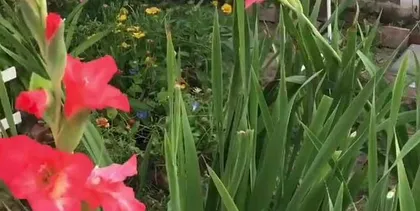Gladiolus is a common ornamental plant, but sometimes we find that it doesn't bloom. In this case, we need to understand its growing environment, care methods, and potential pest and disease problems to help it recover and bloom beautifully.

I. Understanding Gladiolus
Gladiolus, also known as fan lily, is a perennial herb native to tropical Asia. Its flower stalk is sturdy, reaching up to 1.5 meters or more in height, and it generally blooms in summer. The flowers are mostly white or light purple, shaped like a fan, and very beautiful.
II. Gladiolus Growing Environment
Gladiolus prefers a sunny, well-ventilated environment and a warm, humid climate. The suitable growing temperature is 15°C to 30°C. During the growing process, it needs sufficient water and nutrient supplementation.

III. Gladiolus Care Methods
Gladiolus needs appropriate watering and fertilization during its growth, but excessive water and fertilizer will lead to poor growth. During the growing process, attention should be paid to the cleanliness of its leaves and proper pruning.
IV. Why doesn't Gladiolus bloom?
The reasons why gladiolus does not bloom may be due to environmental factors, lack of nutrients, or pests and diseases. Specifically, possible reasons include insufficient light, insufficient water, excessive nitrogen fertilizer, poor soil quality, and pest and disease infestations.
V. How to determine if Gladiolus is healthy?
The main criterion for judging whether gladiolus is healthy is to observe the condition of its leaves and roots. Healthy gladiolus leaves should be bright green, elastic, and shiny. The roots should be strong and firm, without signs of root rot.

VI. How to prevent pests and diseases in Gladiolus?
In the planting and care process of gladiolus, it is necessary to pay attention to preventing and controlling pests and diseases. Prevention methods include maintaining good ventilation and drainage, timely cleaning of leaves, and using appropriate pesticides and control agents.
VII. How to make Gladiolus bloom quickly?
To make gladiolus bloom quickly, it is necessary to first rule out environmental, nutritional, and pest and disease problems. In addition, during the growing process, the growth rhythm can be appropriately controlled, and nutrient supply can be reduced in time to stimulate its flowering ability.
VIII. Common Gladiolus Pest and Disease Problems
Common gladiolus pest and disease problems include root rot, leaf spot, aphids, and mites. When pests and diseases are found, timely measures need to be taken for treatment and prevention.
IX. Gladiolus Propagation Methods
The propagation methods of gladiolus mainly include division, cuttings, and seed propagation. Among them, division is a more common and simple propagation method, which can be carried out during the growing period of gladiolus.
X. Application Value of Gladiolus
In addition to being an ornamental plant, gladiolus also has certain medicinal value. According to research, gladiolus contains a variety of active ingredients with effects such as antipyretic, sedative, and diuretic.
XI. How to prune Gladiolus correctly?
The precautions for pruning gladiolus include pruning at the right time, avoiding over-pruning, and retaining necessary leaves and flower stalks. During the pruning process, appropriate tools should be used to avoid damaging the gladiolus.
XII. How to water Gladiolus?
The precautions for watering gladiolus include not overwatering, not soaking the leaves and flower stalks, and avoiding water stains. When watering, a sprayer or direct pouring method can be used.
XIII. How to fertilize?
Fertilizing gladiolus requires attention to the amount and timing, avoiding excessive and insufficient application. Organic or chemical fertilizers can be used, but it should not be too frequent.
XIV. How to better manage Gladiolus?
Better management of gladiolus requires attention to environmental, nutritional, and pest and disease issues. During the growing process, appropriate adjustments and controls can be made to achieve better growth results.
If we want gladiolus to produce beautiful flowers, we need to pay attention to its growing environment, care methods, and potential pest and disease problems. Only by fully mastering this knowledge can we help gladiolus recover and bloom its most beautiful flowers.